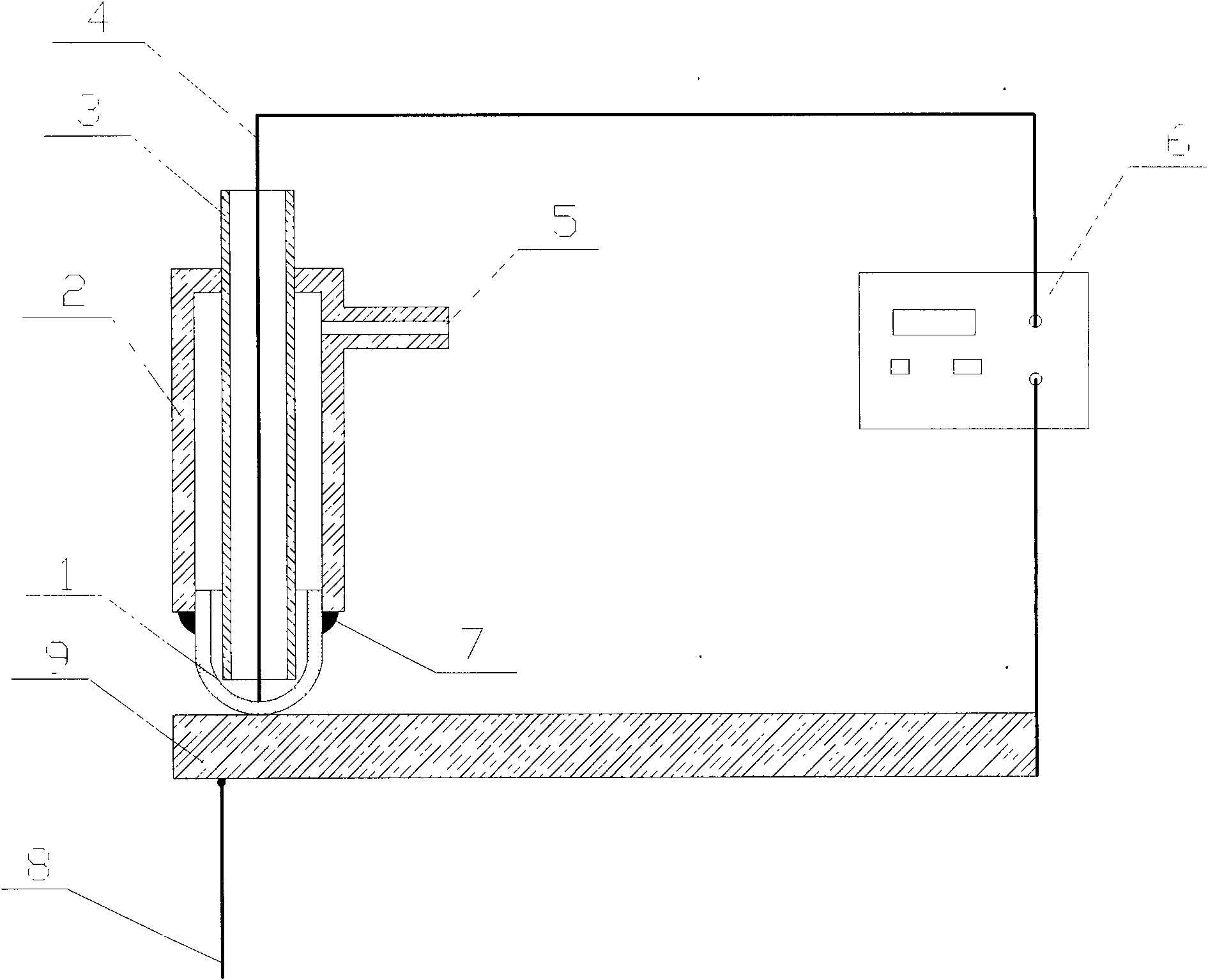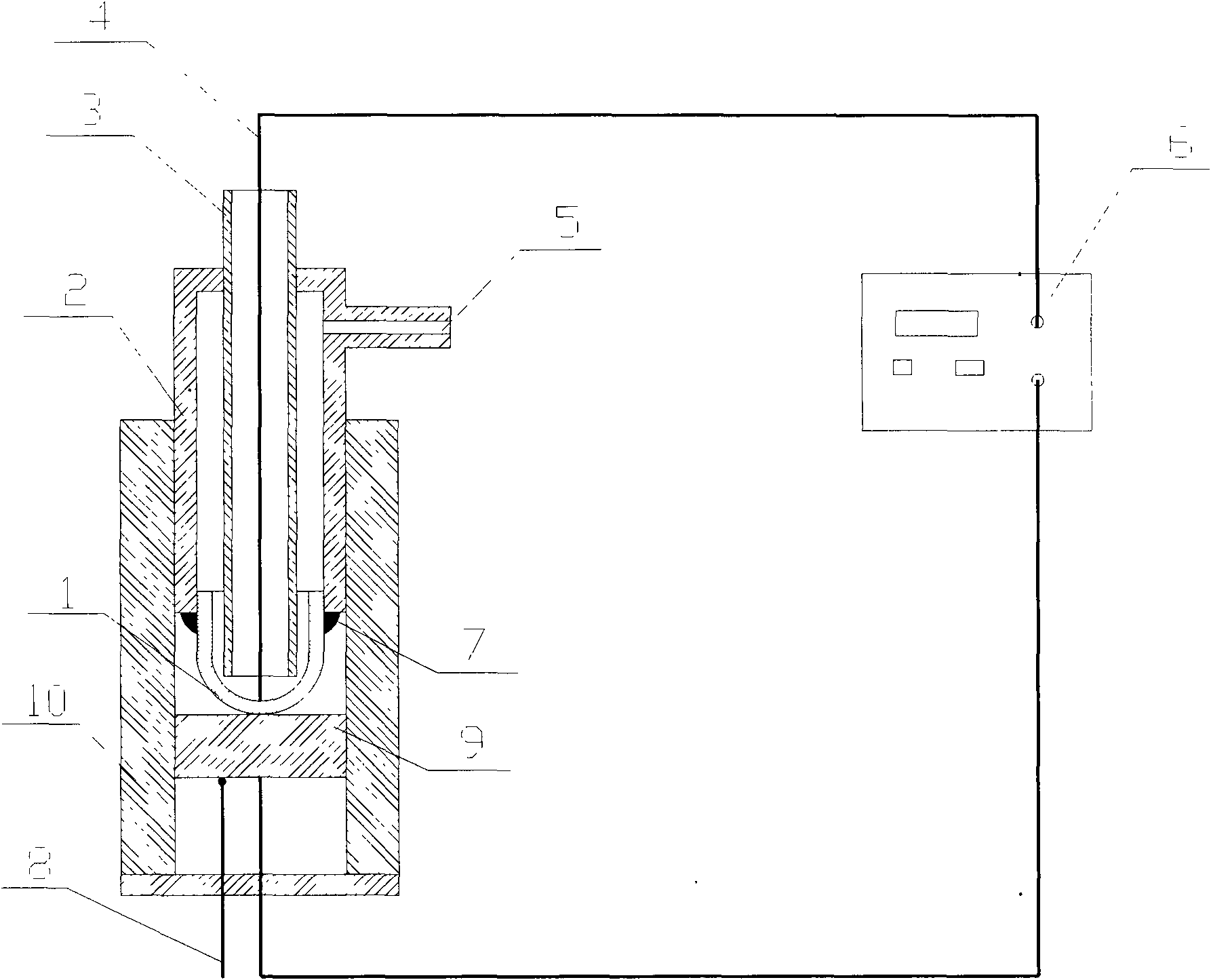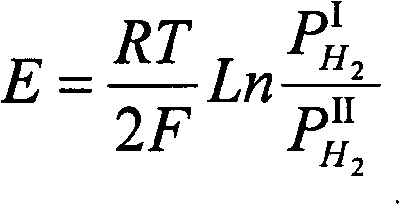Method for measuring hydrogen pressure in solid steel and device
A hydrogen pressure, solid-state technology, applied in the field of solid electrolytes and chemical sensors, can solve problems such as expensive, inconvenient to use, and difficult to store
- Summary
- Abstract
- Description
- Claims
- Application Information
AI Technical Summary
Problems solved by technology
Method used
Image
Examples
Embodiment 1
[0067] The device of the present invention is composed of a ceramic solid electrolyte tube 1, a corundum tube 2, an air intake tube 3, an electrode lead 4, an exhaust tube 5 and a high-resistance digital voltmeter 6, and one end of the corundum tube 2 is connected to the open end of the ceramic solid electrolyte tube 1, That is, the corundum tube 2 and the ceramic solid electrolyte tube 1 are socketed and glued together. Adhesive 7 is selected from commercially available epoxy resin adhesives. The intake pipe 3 passes through the closed end of the corundum tube 2, extends into the corundum tube 2 and is close to the inner wall of the bottom of the ceramic solid electrolyte tube 1, and there is a gap between the outer wall and end surface of the intake tube 3 and the bottom inner wall of the ceramic solid electrolyte tube 1, and the gap can Pass standard hydrogen. An exhaust pipe 5 is provided on the side wall of the corundum pipe 2 . One end of the electrode lead wire 4 exte...
Embodiment 2
[0096]The device of the present invention is composed of a ceramic solid electrolyte tube 1, a corundum tube 2, an air intake tube 3, an electrode lead 4, an exhaust tube 5 and a high-resistance digital voltmeter 6, and one end of the corundum tube 2 is connected to the open end of the ceramic solid electrolyte tube 1, That is, the corundum tube 2 and the ceramic solid electrolyte tube 1 are socketed and glued together. Adhesive 7 is selected from commercially available acrylic resin adhesive. The intake pipe 3 passes through the closed end of the corundum tube 2, extends into the corundum tube 2 and is close to the inner wall of the bottom of the ceramic solid electrolyte tube 1, and there is a gap between the outer wall and end surface of the intake tube 3 and the bottom inner wall of the ceramic solid electrolyte tube 1, and the gap can Pass standard hydrogen. An exhaust pipe 5 is provided on the side wall of the corundum pipe 2 . One end of the electrode lead wire 4 exte...
Embodiment 3
[0125] The device of the present invention is composed of a ceramic solid electrolyte tube 1, a corundum tube 2, an air intake tube 3, an electrode lead 4, an exhaust tube 5 and a high-resistance digital voltmeter 6, and one end of the corundum tube 2 is connected to the open end of the ceramic solid electrolyte tube 1, That is, the corundum tube 2 and the ceramic solid electrolyte tube 1 are socketed and glued together. Adhesive 7 is selected from commercially available instant dry adhesive (502 glue). The intake pipe 3 passes through the closed end of the corundum tube 2, extends into the corundum tube 2 and is close to the inner wall of the bottom of the ceramic solid electrolyte tube 1, and there is a gap between the outer wall and end surface of the intake tube 3 and the bottom inner wall of the ceramic solid electrolyte tube 1, and the gap can Pass standard hydrogen. An exhaust pipe 5 is provided on the side wall of the corundum pipe 2 . One end of the electrode lead w...
PUM
| Property | Measurement | Unit |
|---|---|---|
| Outer diameter | aaaaa | aaaaa |
| Tube wall thickness | aaaaa | aaaaa |
| Tube length | aaaaa | aaaaa |
Abstract
Description
Claims
Application Information
 Login to View More
Login to View More - R&D
- Intellectual Property
- Life Sciences
- Materials
- Tech Scout
- Unparalleled Data Quality
- Higher Quality Content
- 60% Fewer Hallucinations
Browse by: Latest US Patents, China's latest patents, Technical Efficacy Thesaurus, Application Domain, Technology Topic, Popular Technical Reports.
© 2025 PatSnap. All rights reserved.Legal|Privacy policy|Modern Slavery Act Transparency Statement|Sitemap|About US| Contact US: help@patsnap.com



